This is a guest contribution by Boston-based composer/sound designer Renzo Heredia.
My takeaway from GDC was this essential rule in life: Be the change you want to see in the world. If it doesn’t exist, create it yourself.
This applied to all of the knowledge I learned from talks and seeing how powerful a community can be. Whether you are creating a unique musical composition, an unorthodox sound effect, or forming a meetup group for your own local town, you have the power to influence the games you work on and the people you interact with, just as much as they can influence you. I’ll share what I learned at GDC 2017 that contributed to this theme of creating and becoming the change you desire.
The Sound and Music of ‘Hyper Light Drifter’
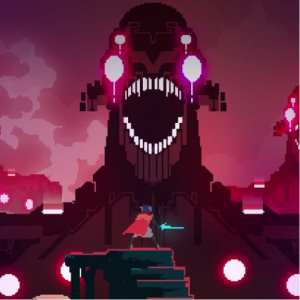
Rich Vreeland, aka Disasterpeace, and Akash Thakkar both teamed up to create music and sound effects for Hyper Light Drifter, and talked about how they each worked to make the right “sound” for the game. Rich focused on experimental ideas that fit the game’s retro, 8-bit visual style. One idea was to record his music through a cassette deck for an old sound. The idea unfortunately failed because you lose synchronization of the layers of music as it starts to phase and become too distorted. Might be a neat idea to take away from a game that could succeed with this sound in the right context, though.
Meanwhile, Akash focused on experiments in sound design, such as using a wire recorder that hiccups and creates distortion in a sound when recorded directly on the wire. Great way to get old-school sounds without resorting straight to bitcrushing. Akash also used a stethoscope microphone to record very quiet sounds, like the sound of his own bloodstream that became a dark hallway sound in the game.
A great moment as well was seeing Akash’s sound design process, such as hearing a demo of one of his boss screams, which came from a raw recording of him making a pig squeal, then bitcrushing that and adding reverb. Hearing that raw sound of Akash just squealing away at his microphone was hilarious, but it’s fantastic hearing how such a weird recording can work very well when trying to get that right “sound”, even if the method is unorthodox. We were also presented with a Logic Pro video of what each layer of a weapon effect sounded like before the layers were bounced together, showcasing high and low-end details to just one sound.
Overall, both of these audio designers showcased in detail how to create unique effects, the ideas they went through, and showed a quality bar that composers and designers can reach for when making their own art.
Composer Confessions: Massive, Often Painful, Lessons Learned
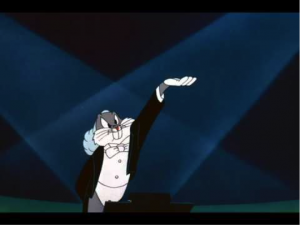
Now this was quite a roundup. Austin Wintory, Grant Kirkhope, Will Roget, Jason Graves, Rich Vreeland, and Mick Gordon, all in one panel, each having a confession and a different takeaway from experiences they’ve had in their past compositions and client/player feedback moments. These were my personal favorite takeaways, although all 6 composers had fantastic stories to share.
1.) Austin showed different YouTube comments from players listening to his music, each of whom would hear his compositions from both Journey and Abzu as either relaxing and soothing or confusing and frantic, each time having the opposite reaction that Austin wanted in the music. Imagine having your player or client not understand the intent of your music. But in reality, as Austin points out, your music will never satisfy everyone, and if it fits the game, you should feel proud of your work and realize that negative feedback is never objective.
2.) Will Roget talked about his struggles when making orchestrated music pieces for Star Wars: The Old Republic. He showed us his sheet music parts for instruments that, admittedly, were either empty of notes to play for many measures, or just almost impossible to play, such as the incredible octave leaps he had his harpist attempt to play in the live sessions. This cost time and money in the live orchestra recordings. Once he refreshed his knowledge on how to orchestrate, to which he recommended Sam Adler’s “Art of Orchestration” book, his craft became much more organized and playable once he worked on Lara Croft and the Temple of Osiris. It’s great seeing how practice and even a tough experience can still help you harness your skill for a future composition gig.
3.) Mick, in wonderful literary fashion, composed a poem that he read to us with Looney Toons images to accompany the lines. His story overall was of his struggle with getting a “sound” that fit the client’s desired musical genre. Each revision of music, no matter how many were made, resulted in being criticized that the music didn’t fit the genre they were looking for, whether they wanted something more “dubstep” or more “heavy rock” or more “baroque”. What a mix! This frustrated Mick, but his takeaway from this experience, instead of criticizing the client, is that he could have initiated more conversation and discussion himself. There is always room to get to know your client, and you can spark a fantastic relationship by just taking the time to talk to your client, whether about the gig or about your client’s own life and interests.
Redefining the Sound of the Great War: Soundscape of ‘Battlefield 1’
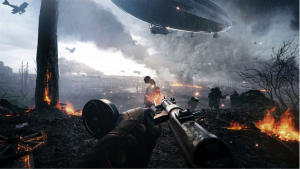
I was very fascinated by this talk on making the World War I sound design of Battlefield 1. Bence Pajor and Andreas Almstrom showcased the progression of quality in sound design of their past Battlefield titles. With each title, they always had a way to reference back to their previous game and see what can be improved in their weapon/tank recordings and the overall mix of the audio. For example, they showed how instead of having NPCs fire guns at the same bullet rate, they randomized how many bullets NPCs shot, creating a realistic sound of a human firing their weapon at different times.
With Battlefield I taking place at a time when there are no recordings of WWI, however, both of these audio designers had the task of making the sound themselves through any material they could find, such as written material in books and biographies. They mentioned describing how soldiers described the “whistling” of bullets flying across the field, and researched what materials guns were made of to create sounds that were as appropriate to their time as possible for the game.
BioWare Embedded QA: Your Support Class
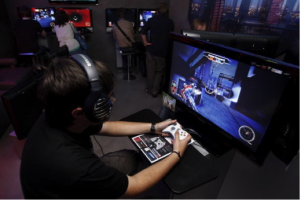
Although Barbara Klimek of Bioware works as a QA team lead and not in audio, she provided a great example of how a team should work together to the best of their abilities to make the game as fantastic as they can.
She stressed the idea of QA using data and embedded models to test their games. For example, saying that a level is “too hard to complete” does not result in a good revision. Being able to point at data to pinpoint why players aren’t completing a level efficiently allows QA to initiate positive feedback and gives the developers a direction to focus on when addressing the issue. This builds team morale through communication and saving time!
She also highlighted a great point that I noticed discussed in the sound designer roundtable as well as the QA roundtable: both disciplines want to be engaged as early as possible in the development timeline of a game. QA and audio want efficient feedback and direction to be able to start work, and the earlier that both disciplines can start looking at a project with enthusiasm and discipline, the work can save so much time and result in tons of opportunity for a polished project.
What was Barbara’s solution to this issue of working late in a project, though? Initiate the conversation. We can’t wait for either your client or your fellow dev team members to simply bring you up to speed in a project. They do have a job of showing us what they would like a game to look and sound like, but it’s our job as audio designers and QA testers to show our passion and by showing up to the team meetings and asking questions to developers when we see an opportunity to raise the quality bar of a game. Just as Mick Gordon highlighted, you can create the needed conversation by starting it yourself.
#GameAudioGDC
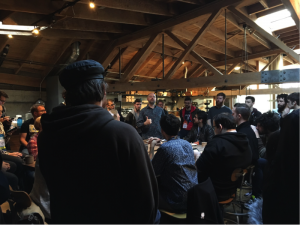
GDC is always known for its presentations and panels. But one unique part about the experience of the conference is what happens just outside of Moscone Center.
Through all of these events, this hashtag, “#GameAudioGDC”, is a great way to keep up to date on what game audio-related events are happening at the conference, and a great way to share anything you learned yourself that day. Not everything was related to the official GDC talks, too.
Damien Kastbauer of PopCap Games and Anton Woldhek of Guerrilla Games both lead the Game Audio Podcast, and at 7am everyday at Sightglass before the conference day officially starts, a roundtable of audio folks is held and recorded! Composers, sound designers, audio programmers, voice actors, you name it. Any profession of any skill level is invited to join the round table. This year, the discussion were led by Damien, where we all talked about what we learned from GDC the previous day and what we were looking forward to on the present day.
This discussions are always wonderful in that they can either be technical, like discussion FMOD vs. Wwise or the best microphones to use in voice recording, or social and philosophical, like the motivations we all have that led us to our profession or if our profession can help make the world a better place. As a young sound designer who’s only been to GDC twice, it is incredible to find a place where I can learn all of these ideas from both students and professionals, and that we all have something to contribute to the discussion, even when just being present and listening.
These are great to attend especially after listening to many talks and wanting to discuss the ideas learned. There were ideas brought up the day after the Composer Confessions panel, like different ways a person can strike a conversation with a client when we are confused about what to do in the music or sound of a project. Maybe we should invite our client to coffee. Maybe we should schedule more Skype sessions. Maybe we should remember to find small moments of time to chat about others things in life, like common interests or other things happening in a person’s life.
Damien created this community get-together with coffee and discussion as a way to share our strengths and challenges, a way to forget about the competition of finding the gig and being able to learn from one another.
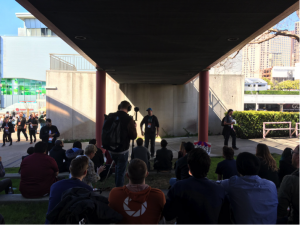
Another great unofficial community get-together, initiated by Matthew Marteinnson of Klei Entertainment, is CarouselCon! Everyday from 12-2pm, we met by the carousel in a grassy area to bring lunch and find new folks to chat with, another awesome way to talk to people about GDC or about anything in general. Wednesday to Friday, microtalks were held by some of us, where we talked for 10 minutes about a subject we wanted to contribute to the group that day. Again, anyone of any skill level was invited to join in.
The best part? On Friday, we all actually got on the carousel. Childhood mode engaged!
GDC 2017 Overall Takeaway
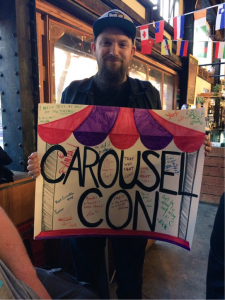
Be the change you want to see in the world. If it doesn’t exist, create it yourself.
Lots of professionals gave great talks on how simply creating an idea or creating a change in the sound of a music or effect can result in something wonderful. And this GDC made me realize the immense power we all have in our own decision-making and discussions we can have and create.
The best part is that the unofficial community get-togethers were all sparked by conversations of people who wanted more time together at the conference, and more ways to share ideas together. CarouselCon seemed like such a wonderful idea, and yet it was only the first year it started!
I wanted to write this article because of how much I enjoy learning from others, and from that enjoyment, I want to contribute knowledge and ideas by sharing them. If you got to experience #GameAudioGDC, talk about it. Share your thoughts. Share the knowledge you learned. And with that knowledge, continue to make your amazing art in music and sound. Continue to engage in conversation with everyone around you, and be genuinely interested in the ideas and thoughts offered. No matter who you are, you have something wonderful to share, and I can’t personally wait to hear some of your own thoughts as well.
And if you don’t have a community in your local city to share ideas with? Start it now. Make a group on Meetup.com. Start a hashtag. Ask everyone you meet a question or two. You have an amazing power, and we can only grow stronger when we share our ideas and experiences.
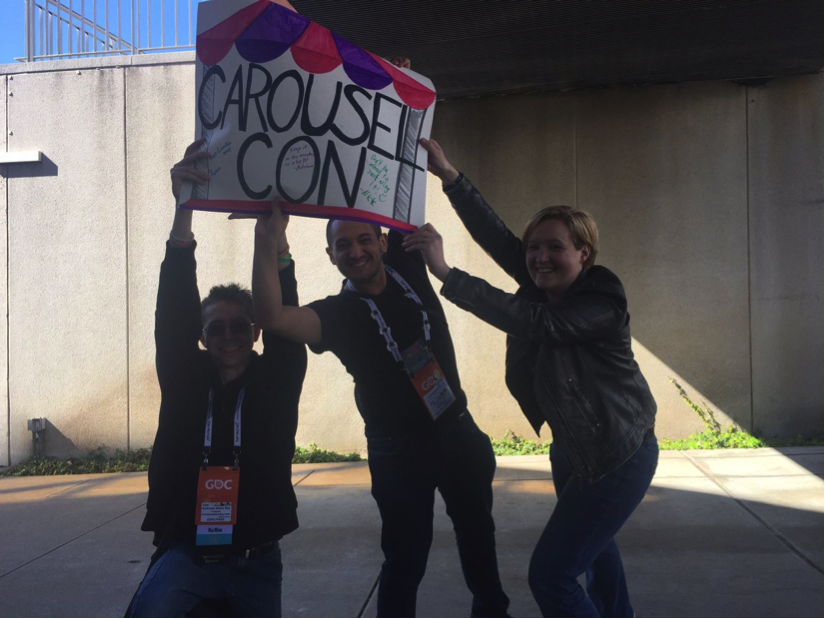
Thanks to Renzo for contributing his reflections on GDC this year. You can find out more about Renzo and his work at www.renzogheredia.com.
Great overview! Thanks so much for this!